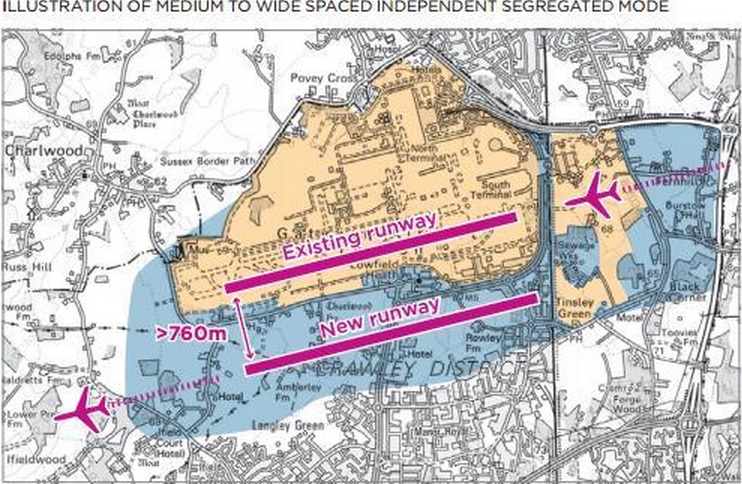Airports Commission publishes interim report with 2 options for a runway at Heathrow and 1 at Gatwick. Estuary still being considered
The Airports Commission’s interim report has put forward 3 options for a new runway, and have kept their options open on an estuary airport. There would only be one runway, not two and they consider this should be in operation before 2030. At Heathrow the choices are a north west runway, 3,500 metres long, destroying Harmondsworth; and an extension westwards of at least 3,000 metres, of the existing northern runway. They also consider a wide spaced Gatwick runway to the south. The Commission also says “there is likely to be a demand case for a 2nd additional runway to be operational by 2050.” They claim this is “consistent with the Committee of Climate Change’s advice to government on meeting its legislated climate change targets.” Stansted is ruled out, and on the Thames Estuary they say: “The Commission has not shortlisted any of the Thames Estuary options because there are too many uncertainties and challenges surrounding them at this stage. It will undertake further study of the Isle of Grain option in the first half of 2014 and will reach a view later next year on whether that option offers a credible proposal for consideration alongside the other short-listed options.” The report also contains recommendations to the government for immediate action to improve the use of existing runway capacity. Among others, these include better airspace organisation and surface transport improvements such as enhancement of Gatwick station, a rail link from the south to Heathrow, and a rail link between Heathrow and Stansted.
.
Airports Commission publishes interim report
17 December 2013 (Airports Commission press release)
Airports Commission: interim report (228 pages)
Various associated papers are also at https://www.gov.uk/government/publications/airports-commission-interim-report
Airports Commission: interim report – appendix 3 technical appendix PDF, 1.41MB, 116 pages contains a section on carbon emissions from pages 64 to 72.
The independent review concludes that there is a need for one additional runway to be in operation in the south east of the UK by 2030.
Aircraft in flight
The Airports Commission’s independent review into airport capacity and connectivity in the UK has concluded that there is a need for one net additional runway to be in operation in the south east by 2030. Its analysis also indicates that there is likely to be a demand case for a second additional runway to be operational by 2050.
These conclusions are valid across a range of assumptions about future demand growth, and are consistent with the Committee of Climate Change’s advice to government on meeting its legislated climate change targets.
The Airports Commission’s interim report published today (17 December 2013) has announced that it will be taking forward for further detailed study proposals for new runways at two locations:
Gatwick Airport
Gatwick Airport Ltd’s proposal for a new runway to the south of the existing runway
.
Heathrow Airport (two options)
Heathrow Airport Ltd’s proposal for one new 3,500m runway to the northwest
Heathrow Hub’s proposal to extend the existing northern runway to at least 6,000m, enabling the extended runway to operate as two independent runways.
.
The next phase of its work will see the Commission undertaking a detailed appraisal of the three options identified before a public consultation in autumn next year.
The Commission has not shortlisted any of the Thames Estuary options because there are too many uncertainties and challenges surrounding them at this stage. It will undertake further study of the Isle of Grain option in the first half of 2014 and will reach a view later next year on whether that option offers a credible proposal for consideration alongside the other short-listed options.
The Commission has not shortlisted proposals for expansion at Stansted or Birmingham, however, there is likely to be a case for considering them as potential options for any second new runway by 2050. In its final report the Commission will set out its recommendations on the process for decision making on additional capacity beyond 2030.
The report also contains recommendations to the government for immediate action to improve the use of existing runway capacity.
– an ‘optimisation strategy’ to improve the operational efficiency of UK airports and airspace, including
… airport collaborative decision making
… airspace changes supporting performance based navigation
… enhanced en-route traffic management to drive tighter adherence to schedules
… time based separation
.
– a package of surface transport improvements to make airports with spare capacity more attractive to airlines and passengers, including
… the enhancement of Gatwick Airport Station
… further work to develop a strategy for enhancing Gatwick’s road and rail access
… work on developing proposals to improve the rail link between London and Stansted
… work to provide rail access into Heathrow from the south
… the provision of smart ticketing facilities at airport stations
.
– trials at Heathrow of measures to smooth the early morning arrival schedule to minimise stacking and delays and to provide more predictable respite for local people
– the establishment of an Independent Noise Authority to provide expert and impartial advice about the noise impacts of aviation and to facilitate the delivery of future improvements to airspace operations.
.
Launching the report Sir Howard Davies Chair of the Commission said:
“Decisions on airport capacity are important national strategic choices and must be based upon the best evidence available. The Commission has undertaken a fresh, comprehensive and transparent study of the issues. This report is the product of extensive consultation, independent analysis and careful consideration by the commissioners.
“The UK enjoys excellent connectivity today. The capacity challenge is not yet critical but it will become so if no action is taken soon and our analysis clearly supports the provision of one net additional runway by 2030. In the meantime we encourage the government to act on our recommendations to make the best of our existing capacity.
“The Commission will now focus on the challenge of appraising the three options, further assessing the case for a new airport in the Thames Estuary, and delivering a robust final recommendation to government in summer 2015.”
The report notes the historic failure to deliver new airport capacity in the UK and the Commission’s independent approach to the challenge. It confirms that a fresh look at the UK’s aviation needs was timely and necessary, setting out how much the global economy, the aviation industry and the domestic and international policy environment has evolved since the government last considered these issues in the 2003 ‘Air transport white paper’.
The report sets out how well connected the UK is currently; how effectively the UK aviation industry has innovated and adapted to change and emerging capacity constraints to remain a world leader; and how new aircraft, new markets and the need to address climate change will present new opportunities and challenges. The report identifies that negative impacts are likely to proliferate as capacity constraints intensify, including in the areas of resilience, connectivity, economic growth and passenger experience.
To inform its assessment of need the Commission has improved how future aviation demand is forecast. It has reviewed the assumptions in the existing model, considered the impact of a carbon constraint to take account of the UK’s current environmental commitments and employed scenario testing to evaluate its key conclusions. The Commission also considered whether the UK requires additional hub or non-hub capacity. It has concluded that the UK will need an airport system that can support both hub and non-hub capacity, and cater for a range of airline business models.
https://www.gov.uk/government/news/airports-commission-publishes-interim-report
Report at
.
.
Documents from the Airports Commission
Airports Commission: interim report
PDF, 4.34MB, 228 pages
.
Airports Commission: interim report – appendix 1 assessment of short- and medium-term options
PDF, 157KB, 33 pages
.
Airports Commission: interim report – appendix 2 assessment of long-term options
PDF, 145KB, 38 pages
.
Airports Commission: interim report – appendix 3 technical appendix
PDF, 1.36MB, 116 pages
.
.
Responding to the Airports Commission’s interim announcement, campaigners vow to fight any expansion at Heathrow
December 17, 2013
The long-awaited interim report from the Airports Commission has now been released. After leaks that Heathrow had been the main choice for another runway, this was confirmed. The shortlist sets out 3 main options: the north west runway at Heathrow, (not demolishing Sipson, but putting it right under the flight path); the northern runway option of the Heathrow Hub concept, which had suggested two runways, built west of the existing ones; and a second runway at Gatwick. Stansted is ruled out. Most Thames estuary options are ruled out, but the Isle of Grain proposal will be given further consideration and is not yet “ruled in or ruled out”. The Commission will be deciding over the next 18 months on whether the runway should be at Gatwick or at Heathrow. There is already fury over much of west London, that people face not only uncertainty for the next year and a half, till the Commission’s final report in summer 2015, but also the nightmare of a massive increase in the number of flights. The announcement will act as the trigger to 18 months of intense campaigning against Heathrow expansion, and against Gatwick expansion. John Stewart, chair of HACAN, said that at Heathrow “The scale of the opposition will be so great that we believe that they are politically undeliverable and should have been dropped at this stage.” Click here to view full story…
North west runway – built over M25 and moves Heathrow closer to Windsor. Cost £17 bn and demolition of 950 homes 
The westerly extension of Heathrow’s northern runway (from the “Heathrow Hub” proposal)

The southern Gatwick runway option

.
.
.
.

